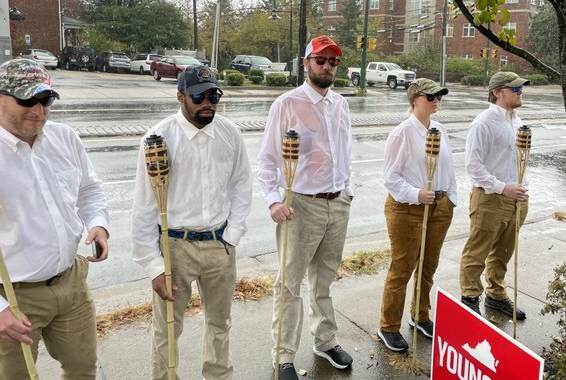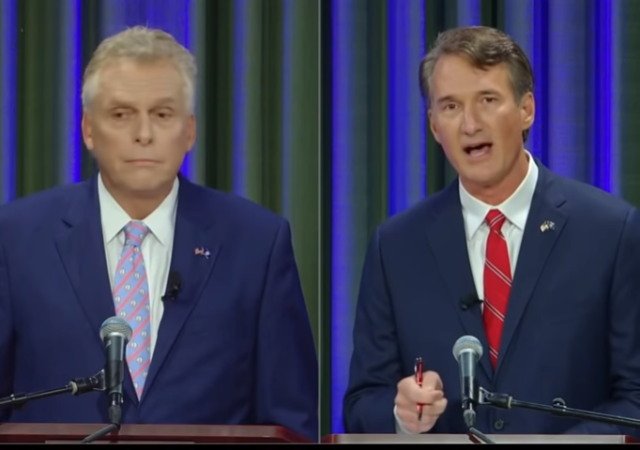
Democrat operatives pose as racists at a Glenn Youngkin campaign stop.
Robert B. Sklaroff, M.D., F.A.C.P. released his analysis of the 2021 midterms on Wednesday morning.
It is clear from the results that 48 hours after the election Democrats were able to produce enough ballots to steal New Jersey.
While Glenn Youngkin ran a solid campaign and won a resounding victory in Virginia, the election was not without Democrat dirty tricks.
Dr. Bob put together this fraud list from the Virginia 2021 election. Since the Republican Party will not address these issues it will be up to patriotic Americans to ensure free and fair elections moving forward.
Virginia Gubernatorial Race.
Glenn Youngkin won after promising to place parents in charge of schools, to help businesses create jobs, and to ban arbitrary government rules/lockdowns. And he promised proper application of five election policies: [1]—update voter rolls monthly; [2]—strengthen voter-ID no matter the manner of voting; [3]—verify all mall-in applications and ballots are legitimate/timely; [4]—require observers during tabulation and the audit of voting machines; and [5]—establish a politically independent/transparent Department of Elections.
{The above was squished; what follows is copied verbatim due to Tim Griffin’s intimate knowledge of what transpired, although minor edits have been made to optimize narrative flow.}
Was there election fraud in Virginia? The legacy media is making the case that the sore losers from 2020 aren’t saying anything about the Virginia Governor’s race because they won, and they only complain about election fraud when they lose. Obviously, the sting of fraud hurts less when your candidate wins, but that doesn’t mean that Virginia had a perfect election. I served as a poll observer with Christine Brim and a few others in Virginia’s largest jurisdiction — Fairfax County, outside of Washington D.C. Virginia was much better than what I witnessed in Detroit and Atlanta over the last year, but that isn’t to say it didn’t have problems. We saw a host of problems:
- Poll Observer Access. Fairfax limited poll observers to ONE per room. Usually about two – four teams of workers were processing absentee ballots, and would allow one observer per political party access.
- Temporary Workers. Although Virginia law requires political party parity between the hiring of election workers, the army of temporary workers hired to pre-process ballots are not required to identify their political party. A supervisor told me that they were all non-partisan. The problem with this is that Fairfax is 70/30 democrat-to-republican, and government workers from other departments often take these positions. This creates a major imbalance in the bipartisan process.
- USB Flash Drives Unreliable. Fairfax County had 16 early voting “satellite office” precincts where voters could show up to vote early up to 45 days before the election. Voters would vote on a literal paper ballot OR on a BMD (Ballot Marking Device), where they would vote on a screen and would be issued a sheet of paper that identified their votes, but had a unique barcode that is unreadable by the human eye, which serves as the record the machine tabulator will use to tabulate votes. I was told that early voting sites promoted the use of BMDs, while mail-in absentee ballots were pure paper ballot voting. This is interesting because mail-in voting heavily favors democrats, whereas early voting does not and even favored republicans in some areas of the Commonwealth. The tabulators used were made by ES&S. ES&S tabulators accept the ballots, extract the data needed to count the ballots, record this info on the flash drives. A flash drive could record about 7k votes before the flash drive was full. Each flash drive had both a primary and a backup drive that were kept together. Under Virginia law, votes are not allowed to be counted until after 7:00 PM on election night. However, all of the counts are knowable for those in possession of the flash drives (although this would technically be illegal). What Christine and I witnessed was a large number of the Flash drives had not been properly formatted OR had been in machine tabulators that were not properly shut down. This led to tens of thousands of ballots having to be re-counted on election day. Machine proponents would say, “this is how you know this system is working because there was a problem, so we went back to the source and required a literal paper ballot recount”. However, if close to a quarter of your flash drives are failing, it doesn’t give me confidence in the system.
- Masks. Masks continued to be a way to suppress right-leaning voters and observers. All throughout the day we heard stories of voters and observers being turned away for not wearing masks inside of a precinct. Most registrars seemed to be good about making sure that local election offices were overruled and voters allowed to vote. But how many voters were turned away and didn’t complain or call for backup — but instead simply drove away?
- Miscounts. As a result of the error messages on the USB drives, some satellite offices had to be recounted. The paper ballots were pulled. The ballots pulled from one of the early precincts was especially interesting. The Mount Vernon precinct had about 11,336 voters vote early. These paper ballots were divided up into eight separate cardboard boxes, sealed, and had a report on the outside of the box. The report had the date range these ballots had been accepted, the precinct, a box number, the total number of ballots inside of the box, and I believe many of them had the signature of the person who had filled the box. Mount Vernon Box #362 was marked as having 478 ballots. However, when the box was opened up and re-counted, it had 1,532 ballots.
No one could explain why a sealed box with less than 500 ballots suddenly had more than 1,500 ballots. I spoke directly with the registrar multiple times on this issue. At the end of the day, he determined that because the entire precinct had recorded 11,336 voters, and the recount revealed 11,332 ballots (missing four ballots — I don’t recall the reason for this) — that all was well. But when I asked him WHERE and WHEN these extra ballots may have come from, why the notes on report were incorrect, whether another box of ballots was 1k ballots short, etc…. there was no answer. 1,000 un-explainable ballots in one precinct is a lot. I should note that a GOP-retained attorney observer had a follow-up conversation with the registrar and felt that the reason for the ballots was acceptable. I never received an explanation.
- Center for Civic Design. You will remember the Center for Civic Designwas a left-leaning non-profit heavily involved in the 2020 election. This group was involved in creating ballot designs, and plans to count massive amounts of mail-in ballots. Our own AVA Jacqueline spoke to us about their involvement in the California recall race this year and the holes in the ballot envelopes. Officials for CCD as well as a representative of the U.S. Elections Assistance Commission came to the Fairfax Registrar’s office and were given a secret meeting and private tour of the facilities and process on election day. None were willing to identify themselves. The registrar told me that the reason the three reps from CCD were there is because they were working in conjunction on a project with the U.S. Elections Assistance Commission. The one lady who was in Fairfax with CCD from the Elections Assistance Commission would not provide a card or name. Scott stated to me she was the Executive Director of the Commission. Based on this information, I believe it was Mona Harrington.
- Certification. Following the canvass effort that is wrapping up this week in most localities, the election will be certified by the State Board of Elections, a panel of political appointees that the governor appoints, with a one-party edge to the governor’s party. The position of AVA continues to be that elections should be overseen by a joint-standing committee of both houses of the legislature so that there is accountability in the process. This unelected board of political appointees are far removed from accountability to citizens, voters, and taxpayers.
- Political Party Observers. My personal experience in this election was that political party observers from all political parties were a complete joy to work with. This stands in stark contrast to a place like Detroit where I personally observed democrat poll watchers attempt to have republican poll observers arrested. Poll watchers called each other names, stalked, intimidated, etc. I mention this only because election observers must know their terrain and prepare for what those opposed to honest and transparent elections may do.
- Pre-processing of Absentee Ballots. Virginia had pre-processed almost all absentee and early ballots prior to election day in 2021. This meant that by the time many poll observers showed up on election day, the work was done. The ballots had been identified, logged in the internal VERISsystem, and stacked for tabulation prior to election day. This process began in October. The good news is that early pre-processing avoids the chaos of consolidated counting centers that took place in cities across the nation as they race to count hundreds of thousands of ballots streaming through the door in real-time. The bad news is that if fraud occurred, or procedures were bypassed — these acts would likely be unknowable. Notably, this makes it almost impossible to justify late-night ballot dumps.
- Post-election Ballots. Under a new Virginia law, mail-in absentee ballots can now be accepted until Friday after the election at noon, as long as they are postmarked or even under some circumstances if the postmark is ineligible. This was not a problem for in this year’s election for one simple reason: the winning candidates won by large enough margins that thousands of mail-in ballots would not have helped them. In a very tight election, this process still presents grave danger.
- Write-in candidates. A local school board race saw the writing-in of tens of thousands of names in Bedford County, VA. These names were written onto a traditional paper ballots but many voters used the first line to write the candidates first name, “Matthew” while his last name, “Holbrook” was written below and outside of the box. The local county board of elections was tasked with tabulating the votes. Rather than count the paper ballots, they used the state-directed process where the Dominion machine prints a long receipt (like a grocery store receipt), where they what is written in the box is printed over, and over, and over. This makes it much easier to tabulate. However, it makes it much more difficult to determine a voter’s intent as the only vote the board of elections was shown was “Matthew”. Fortunately, the local Board of Elections voted to accept “Matthew” as a vote for “Matthew Holbrook” and so it didn’t become an issue. But it isn’t difficult to see how this system could be abused in a less gentile jurisdiction.
- Differences from the 2020 Election? One of the most noticeable differences between Virginia 2021, and swing states 2020 is that elections offices in Virginia weren’t flooded with private money, consultants, and get out the vote efforts in left leaning jurisdictions. All of the problems with mail-in ballots remained, but election offices weren’t commandeered into GOTV offices on behalf of left leaving organizations.
- Poll Observers. Republicans had over 90% poll observer coverage across the entire state. That made a huge difference.
- Same Day Registration. It is worth noting that Virginia will have same day registration starting in July, so things are about to get even more complicated.
The post Election Recap: Virginia Gubernatorial Race Was Not Without Attempts by Democrats to Steal Election appeared first on The Gateway Pundit.


